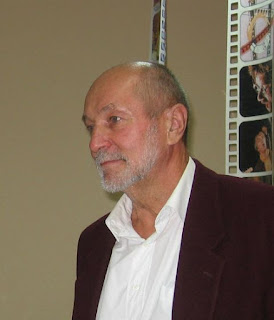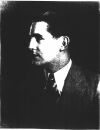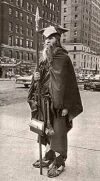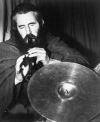Izjemen dvojec, ki je ogromno prispeval k unikatnosti in prepoznavnosti slovenskega animiranega filma.
Ko sem videl koliko ogledov sta izbrala v 7 letih na YT, mi ni ostalo drugega kot, da ju podprem.
Podprite ju še vi!
Sramontno je kakšen odnos imamo do domačih umetnikov.
Vse kar je sosedovo je boljše. Verjemite, to velikokrat ne drži.
Koni Steinbacher, animator in režiser animiranih filmov, se je rodil leta 1940 na Pohorju. Diplomiral je na Pedagoški fakulteti v Ljubljani in od 1964 delal kot učitelj likovnega pouka na osnovni šoli v Izoli. V likovno vzgojo je začel vnašati osnove filmske animacije. Otroci so animirali okoli devetdeset nekaj minutnih filmov in v takratni Jugoslaviji opozorili nase.
Poleti leta 1970 sta Janez Marinšek in Koni Steinbacher na Goriški 9 v Izoli snovala svoj prvi animirani film Govornik. Opogumil ju je velik uspeh filma Ribič, ki so ga pod mentorskim vodstvom Konija Steinbacherja ustvarili otroci na osnovni šoli Vojka Šmuc v Izoli. Oktobra je Govornik prejel Zlato medaljo na takratnem jugoslovanskem festivalu amaterskega filma. Porodilo se je obdobje nove ustvarjalnosti, ki se navezuje na Steinbacherjevo ime, in je združevalo mentorstvo, ustvarjalnost in filmsko vzgojo. Takratna Izola še ni imela posluha za ustvarjalno novost, zato so avtorja filma in glasbenik Emil Zonta prvi filmski klub ustanovili v Kopru. Tam so nastajale nove stvaritve in krog sodelavcev in ustvarjalcev se je širil: Marjan Tomšič, Radovan Čok, Boris Benčič, Iztok Umer, Stanka Bergoč, Gorast Radojevič ...
Za opus animiranih filmov sta Steinbacher in Marinšek leta 1977 prejela nagrado Prešernovega sklada.
Nato sta nadaljevala filmsko pot v okviru takratne slovenske filmske proizvodnje Viba film Ljubljana, vendar je ves ustvarjalni proces potekal v Izoli, posebno še, ker je večino filmov realiziral Steinbacher sam. Po osamosvojitvi Slovenije sta se avtorja preizkušala tudi kot producenta svojih del. Z zadnjim filmom Mrtvaški ples se Steinbacher vrača na svoj začetek: ustvaril ga je samo iz ljubezni do filmske umetnosti.
V letih 1976 - 1986 je Steinbacher samostojno realiziral več filmov, v tandemu z Marinškom pa je v letih 1987- 89 nastala še animirana nadaljevanka Kače.
Med letoma 1993- 1997 je samostojno realiziral pet epizod animirano igrane nadaljevanke Briši-piši (Cansel- pencil) za mladinski program TV Slovenija. Po letu 1999 je realiziral vrsto filmov in za svoje delo prejel več kot petnajst pomembnih priznanj in nagrad.
PRIZNANJA in NAGRADE:
Okoli 70 priznanj in nagrad za amaterske filme doma in tujini
2. 1975 Srebrna medalja Beograd za animirani film Študent
3. 1977 Nagrada Prešernovega sklada za dosežke risanega filma (z J. Marinškom)
3. 1982 Zlata medalja Beograd za mini animirani film Epidemija
4. 1982 Priznanje Sveta YU festivala v Beogradu za pionirsko delo na področju
animiranega filma v Sloveniji.
5. 1975, 1976, 1982 Badjurova priznanja za filme Študent, Močvirje, Epidemija in
Vsiljivec
6. 1985 Zlata medalja Beograd za animirani film Kamen
7. 1989 Medalja Beograd za animacijo filma Kače - Adam in Eva
8. 2000 Priznanje Izolanima za grafično podobo filma Peter Klepec
9. 2002 Priznanje Izolanima za animacijo filma Izdelovalec mask
10. 2005 Srebrna plaketa JSKD Slovenije za dolgoletno filmsko vzgojno dejavnost.
11. 2007 »Sretni Lepenac« priznanje medn. festivala animiranega filma
BALKANIMA Beograd za (življensko delo) prispevek k razvoju animacije na
Balkanu. "Happy Lepenac" Award for the contribution to development of Balkan animation
12: Priznanja občine Izola: 1986, 2000 (Ambasador Izole) in 2012
Priznanje občine Zreče 2009
Sicer velja spomniti, da je bil Koni Steinbacher na 13. FSF v Portorožu dobitnik Vesne za najboljši animirani film, in sicer za kratki animirani film Mrtvaški ples, ki je tudi med zmagovalci 13. mednarodnega festivala Malescorto 2012 v Italiji
FILMOGRAFIJA in sodelovanje na festivalih
1970 Govornik 5 min. AAF Koper (Pula, Welden, Trst)
Korežiser. Janez Marinšek
1971 Figov list 6 min. AAF Koper (Pula, Sarajevo, Skopje, Welden, Trst, Kelibia-Tunis)
Korežiser. Janez Marinšek
1972 Superman 5 min. AAF Koper (Pula, Kelibia-Tunis, Welden, Trst)
Korežiser Janez Marinšek
1973 Koeksistenca, 2min, in Močvirje, 4min. (Pula, Trst, Skopje, Welden, Warszawa
1973 Agonija 5 min. igrano dokumentarni film AAF Koper (Jesenice, Welden, Trst, Pula, Samobor, Zadar)
1974: ŠTUDENT, 8 min. VIBA FILM (Beograd, Celje, Oberhausen, Tampere, Krakow)
Korežiser: Janez Marinšek
1965: PREHITEVANJE 8 min. VIBA FILM (Celje, Beograd)
1976: MOČVIRJE, 8 min. VIBA FILM (Celje, Beograd, Tampere)
1977: VRATA, 8 min. VIBA FILM (Beograd, Zagreb)
1978: KOKON (Metamorfoza) 8 min. VIBA FILM (Celje,Beograd, Bilbao)
1980: ANIMIRANI »A«, 12 min. VIBA FILM (Beograd, Atene)
1982: EPIDEMIJA, 2 min. VIBA FILM (Beograd, Celje, Krakow)
1983: VSILJIVEC, 5 min. VIBA FILM (Celje, Beograd)
1984: KAMEN, 8 min. VIBA FILM (Zagreb, Beograd, Oberhausen, Lucca, Melbourne)
1986: IZMIŠLJENA ZGODBA, 8 min. VIBA FILM (Beograd, Krakow)
1987-89: KAČE, 7 x 4 min. VIBA FILM Korežiser:Janez Marišek
1993-96: BRIŠI PIŠI 5 x 8 min. ARF LJUBLJANA in TV Slovenja
1999: PETER KLEPEC, 11 min. ARF Ljubljana in TV Slovenija (Zagreb)
2000: VEČERJA, 2 min. ARF Ljubljana (Bologna, Lorret del Mar)
2002: IZDELOVALEC MASK, 8 min ARF Ljubljana (Imola, Brunschweig, Barcelona, Beograd, Almeria)
2004: 99 % (SNEGULJČICA 2002) 7 min. MAYA ART (Beograd)
Korežiser: Janez Marinšek.
2007: LEPA NEDELJA PRI SV.JAKOKOBU NA RESNIKU, 8 min, MAYA ART (Beograd)
2008: EN GLAŽEK AL' PA DVA 5,05 min. TV Slovenija-mladinski program
2010: MRTVAŠKI PLES 4 min. KOST (Beograd, Čačak, Trst, Malesco, Patras
2011: GREMO V RAJ, 12 min. KOST (Korežiser Janez Marinšek)
ZAKAJ JE ISTRA TUŽNA, v produkciji KOST
Literatura
Filmografija
Režiser
Telematerija (1973)
Študent (1975)
Prehitevanje (1976)
Močvirje (1976)
Vrata (1978)
Kokon (1979)
Risani »A« (1981)
Epidemija (1982)
Vsiljivec (1982)
Kamen (1984)
Izmišljena zgodba (1986)
Kače - Gordijski vozel (1987)
Kače - Jajce (1987)
Kače - Koeksistenca (1988)
Kače - Lady Co. (1988)
Briši piši - Na zdravje (1995)
Briši piši - Za zdravje (1995)
Briši piši - Za zeleni grič (1995)
Briši piši - Za nova obzorja (1996)
Briši piši - Za boljši zrak (1997)
Peter Klepec (1998)
Večerja (2000)
Izdelovalec mask (2002)
99 % (Sneguljčica) (2004)
Lepa nedelja pri Sv. Jakobu na Resniku (2007)
En glažek al' pa dva (2008)
Mrtvaški ples (2010)
Gremo v raj (2011)
Scenarist
Študent (1975)
Peter Klepec (1998)
Lepa nedelja pri Sv. Jakobu na Resniku (2007)
Mrtvaški ples (2010)
Glavni risar
Telematerija (1973)
Študent (1975)
Prehitevanje (1976)
Močvirje (1976)
Vrata (1978)
Kokon (1979)
Risani »A« (1981)
Epidemija (1982)
Raca (1985)
Kače (1987-89)
Briši piši (1995-1997)
Večerja (2000)
Izdelovalec mask (2002)
Mrtvaški ples (2010)
Animator
Telematerija (1973)
Študent (1975)
Prehitevanje (1976)
Močvirje (1976)
Vrata (1978)
Kokon (1979)
Risani »A« (1981)
Epidemija (1982)
Vsiljivec (1982)
Kamen (1984)
Raca (1985)
Koncert za osle in klavir (1988)
Briši piši (1995-1997)
Večerja (2000)
Peter Klepec (1998)
Izdelovalec mask (2003)
Briši piši (1995-97)
Mrtvaški ples (2010)
Gremo v raj (2011)
Oblikovalec zvoka
Lepa nedelja pri Sv. Jakobu na Resniku (2007)
En glažek al' pa dva (2008)
Mrtvaški ples (2010)
Montažer
Peter Klepec (1998)
En glažek al' pa dva (2008)
Mrtvaški ples (2010)
Gremo v raj (2011)
Janez Marinšek se je rodil leta 1942. Po poklicu je bil ekonomist, na področju kinematografije je deloval kot direktor Globus filma Koper in kot predstavnik distribucije Vesna film Ljubljana, sredi devetdesetih pa tudi na Filmskem skladu Republike Slovenije, sedanjem Slovenskem filmskem centru.
Poleti leta 1970 sta Janez Marinšek in Koni Steinbacher na Goriški 9 snovala svoj prvi animirani film Govornik. Opogumil ju je veliki uspeh filma Ribič, ki so ga pod mentorskim vodstvom Konija Steinbacherja ustvarili otroci na osnovni šoli Vojka Šmuc v Izoli. Oktobra je Govornik prejel Zlato medaljo na takratnem jugoslovanskem festivalu amaterskega filma.
Leta 1971 sta ustvarila Figov list, leto kasneje pa še Supermana. Za svoje amaterske filme sta prejela okoli 70 priznanj in nagrad doma in v tujini.
Svojo profesionalno pot sta nadaljevala pri takratnem edinem slovenskem producentu Viba film in v letih 1973- 1975 posnela animirane filme Telematerija, Študent in Prehitevanje. Leta 1975 sta za animirani film Študent prejela srebrna medaljo mesta Beograd. Leta 1977 sta Janez Marinček in Koni Steinbacher za opus animiranih filmov prejela nagrado Prešernovega sklada.
Leta 1978 je Janez Marinček samostojno režiral animirani film Gor, za katerega je scenarij napisal pisatelj Marjan Tomšič, Janez Marinšek pa je bil tudi glavni animator. S Konijem Steinbacherjem sta ponovno sodelovala v letih 1987 – 1988, ko je nastala serija animiranih filmov z naslovom Kače.
Po osamosvojitvi Slovenije se je Janez Marinšek preizkusil tudi kot koproducent. Leta 2007 je sodeloval pri kratkem animiranem filmu Lepa nedelja pri Sv. Jakobu na Resniku, kjer je režijo zaupal staremu prijatelju in sodelavcu Koniju Steinbacherju. Leta 2009 pa je kot koproducent prvič sodeloval tudi pri igranem srednjemetražnem filmu Moje počitnice, v režiji Aleša Ferenca.
Umrl je 3. 4. 2013.
Mirno morje, kapitan.
Ko sem videl koliko ogledov sta izbrala v 7 letih na YT, mi ni ostalo drugega kot, da ju podprem.
Podprite ju še vi!
Sramontno je kakšen odnos imamo do domačih umetnikov.
Vse kar je sosedovo je boljše. Verjemite, to velikokrat ne drži.
Koni Steinbacher, animator in režiser animiranih filmov, se je rodil leta 1940 na Pohorju. Diplomiral je na Pedagoški fakulteti v Ljubljani in od 1964 delal kot učitelj likovnega pouka na osnovni šoli v Izoli. V likovno vzgojo je začel vnašati osnove filmske animacije. Otroci so animirali okoli devetdeset nekaj minutnih filmov in v takratni Jugoslaviji opozorili nase.
Poleti leta 1970 sta Janez Marinšek in Koni Steinbacher na Goriški 9 v Izoli snovala svoj prvi animirani film Govornik. Opogumil ju je velik uspeh filma Ribič, ki so ga pod mentorskim vodstvom Konija Steinbacherja ustvarili otroci na osnovni šoli Vojka Šmuc v Izoli. Oktobra je Govornik prejel Zlato medaljo na takratnem jugoslovanskem festivalu amaterskega filma. Porodilo se je obdobje nove ustvarjalnosti, ki se navezuje na Steinbacherjevo ime, in je združevalo mentorstvo, ustvarjalnost in filmsko vzgojo. Takratna Izola še ni imela posluha za ustvarjalno novost, zato so avtorja filma in glasbenik Emil Zonta prvi filmski klub ustanovili v Kopru. Tam so nastajale nove stvaritve in krog sodelavcev in ustvarjalcev se je širil: Marjan Tomšič, Radovan Čok, Boris Benčič, Iztok Umer, Stanka Bergoč, Gorast Radojevič ...
Za opus animiranih filmov sta Steinbacher in Marinšek leta 1977 prejela nagrado Prešernovega sklada.
Nato sta nadaljevala filmsko pot v okviru takratne slovenske filmske proizvodnje Viba film Ljubljana, vendar je ves ustvarjalni proces potekal v Izoli, posebno še, ker je večino filmov realiziral Steinbacher sam. Po osamosvojitvi Slovenije sta se avtorja preizkušala tudi kot producenta svojih del. Z zadnjim filmom Mrtvaški ples se Steinbacher vrača na svoj začetek: ustvaril ga je samo iz ljubezni do filmske umetnosti.
V letih 1976 - 1986 je Steinbacher samostojno realiziral več filmov, v tandemu z Marinškom pa je v letih 1987- 89 nastala še animirana nadaljevanka Kače.
Med letoma 1993- 1997 je samostojno realiziral pet epizod animirano igrane nadaljevanke Briši-piši (Cansel- pencil) za mladinski program TV Slovenija. Po letu 1999 je realiziral vrsto filmov in za svoje delo prejel več kot petnajst pomembnih priznanj in nagrad.
PRIZNANJA in NAGRADE:
Okoli 70 priznanj in nagrad za amaterske filme doma in tujini
2. 1975 Srebrna medalja Beograd za animirani film Študent
3. 1977 Nagrada Prešernovega sklada za dosežke risanega filma (z J. Marinškom)
3. 1982 Zlata medalja Beograd za mini animirani film Epidemija
4. 1982 Priznanje Sveta YU festivala v Beogradu za pionirsko delo na področju
animiranega filma v Sloveniji.
5. 1975, 1976, 1982 Badjurova priznanja za filme Študent, Močvirje, Epidemija in
Vsiljivec
6. 1985 Zlata medalja Beograd za animirani film Kamen
7. 1989 Medalja Beograd za animacijo filma Kače - Adam in Eva
8. 2000 Priznanje Izolanima za grafično podobo filma Peter Klepec
9. 2002 Priznanje Izolanima za animacijo filma Izdelovalec mask
10. 2005 Srebrna plaketa JSKD Slovenije za dolgoletno filmsko vzgojno dejavnost.
11. 2007 »Sretni Lepenac« priznanje medn. festivala animiranega filma
BALKANIMA Beograd za (življensko delo) prispevek k razvoju animacije na
Balkanu. "Happy Lepenac" Award for the contribution to development of Balkan animation
12: Priznanja občine Izola: 1986, 2000 (Ambasador Izole) in 2012
Priznanje občine Zreče 2009
Sicer velja spomniti, da je bil Koni Steinbacher na 13. FSF v Portorožu dobitnik Vesne za najboljši animirani film, in sicer za kratki animirani film Mrtvaški ples, ki je tudi med zmagovalci 13. mednarodnega festivala Malescorto 2012 v Italiji
FILMOGRAFIJA in sodelovanje na festivalih
1970 Govornik 5 min. AAF Koper (Pula, Welden, Trst)
Korežiser. Janez Marinšek
1971 Figov list 6 min. AAF Koper (Pula, Sarajevo, Skopje, Welden, Trst, Kelibia-Tunis)
Korežiser. Janez Marinšek
1972 Superman 5 min. AAF Koper (Pula, Kelibia-Tunis, Welden, Trst)
Korežiser Janez Marinšek
1973 Koeksistenca, 2min, in Močvirje, 4min. (Pula, Trst, Skopje, Welden, Warszawa
1973 Agonija 5 min. igrano dokumentarni film AAF Koper (Jesenice, Welden, Trst, Pula, Samobor, Zadar)
1974: ŠTUDENT, 8 min. VIBA FILM (Beograd, Celje, Oberhausen, Tampere, Krakow)
Korežiser: Janez Marinšek
1965: PREHITEVANJE 8 min. VIBA FILM (Celje, Beograd)
1976: MOČVIRJE, 8 min. VIBA FILM (Celje, Beograd, Tampere)
1977: VRATA, 8 min. VIBA FILM (Beograd, Zagreb)
1978: KOKON (Metamorfoza) 8 min. VIBA FILM (Celje,Beograd, Bilbao)
1980: ANIMIRANI »A«, 12 min. VIBA FILM (Beograd, Atene)
1982: EPIDEMIJA, 2 min. VIBA FILM (Beograd, Celje, Krakow)
1983: VSILJIVEC, 5 min. VIBA FILM (Celje, Beograd)
1984: KAMEN, 8 min. VIBA FILM (Zagreb, Beograd, Oberhausen, Lucca, Melbourne)
1986: IZMIŠLJENA ZGODBA, 8 min. VIBA FILM (Beograd, Krakow)
1987-89: KAČE, 7 x 4 min. VIBA FILM Korežiser:Janez Marišek
1993-96: BRIŠI PIŠI 5 x 8 min. ARF LJUBLJANA in TV Slovenja
1999: PETER KLEPEC, 11 min. ARF Ljubljana in TV Slovenija (Zagreb)
2000: VEČERJA, 2 min. ARF Ljubljana (Bologna, Lorret del Mar)
2002: IZDELOVALEC MASK, 8 min ARF Ljubljana (Imola, Brunschweig, Barcelona, Beograd, Almeria)
2004: 99 % (SNEGULJČICA 2002) 7 min. MAYA ART (Beograd)
Korežiser: Janez Marinšek.
2007: LEPA NEDELJA PRI SV.JAKOKOBU NA RESNIKU, 8 min, MAYA ART (Beograd)
2008: EN GLAŽEK AL' PA DVA 5,05 min. TV Slovenija-mladinski program
2010: MRTVAŠKI PLES 4 min. KOST (Beograd, Čačak, Trst, Malesco, Patras
2011: GREMO V RAJ, 12 min. KOST (Korežiser Janez Marinšek)
ZAKAJ JE ISTRA TUŽNA, v produkciji KOST
Literatura
Filmografija
Režiser
Telematerija (1973)
Študent (1975)
Prehitevanje (1976)
Močvirje (1976)
Vrata (1978)
Kokon (1979)
Risani »A« (1981)
Epidemija (1982)
Vsiljivec (1982)
Kamen (1984)
Izmišljena zgodba (1986)
Kače - Gordijski vozel (1987)
Kače - Jajce (1987)
Kače - Koeksistenca (1988)
Kače - Lady Co. (1988)
Briši piši - Na zdravje (1995)
Briši piši - Za zdravje (1995)
Briši piši - Za zeleni grič (1995)
Briši piši - Za nova obzorja (1996)
Briši piši - Za boljši zrak (1997)
Peter Klepec (1998)
Večerja (2000)
Izdelovalec mask (2002)
99 % (Sneguljčica) (2004)
Lepa nedelja pri Sv. Jakobu na Resniku (2007)
En glažek al' pa dva (2008)
Mrtvaški ples (2010)
Gremo v raj (2011)
Scenarist
Študent (1975)
Peter Klepec (1998)
Lepa nedelja pri Sv. Jakobu na Resniku (2007)
Mrtvaški ples (2010)
Glavni risar
Telematerija (1973)
Študent (1975)
Prehitevanje (1976)
Močvirje (1976)
Vrata (1978)
Kokon (1979)
Risani »A« (1981)
Epidemija (1982)
Raca (1985)
Kače (1987-89)
Briši piši (1995-1997)
Večerja (2000)
Izdelovalec mask (2002)
Mrtvaški ples (2010)
Animator
Telematerija (1973)
Študent (1975)
Prehitevanje (1976)
Močvirje (1976)
Vrata (1978)
Kokon (1979)
Risani »A« (1981)
Epidemija (1982)
Vsiljivec (1982)
Kamen (1984)
Raca (1985)
Koncert za osle in klavir (1988)
Briši piši (1995-1997)
Večerja (2000)
Peter Klepec (1998)
Izdelovalec mask (2003)
Briši piši (1995-97)
Mrtvaški ples (2010)
Gremo v raj (2011)
Oblikovalec zvoka
Lepa nedelja pri Sv. Jakobu na Resniku (2007)
En glažek al' pa dva (2008)
Mrtvaški ples (2010)
Montažer
Peter Klepec (1998)
En glažek al' pa dva (2008)
Mrtvaški ples (2010)
Gremo v raj (2011)
Janez Marinšek se je rodil leta 1942. Po poklicu je bil ekonomist, na področju kinematografije je deloval kot direktor Globus filma Koper in kot predstavnik distribucije Vesna film Ljubljana, sredi devetdesetih pa tudi na Filmskem skladu Republike Slovenije, sedanjem Slovenskem filmskem centru.
Poleti leta 1970 sta Janez Marinšek in Koni Steinbacher na Goriški 9 snovala svoj prvi animirani film Govornik. Opogumil ju je veliki uspeh filma Ribič, ki so ga pod mentorskim vodstvom Konija Steinbacherja ustvarili otroci na osnovni šoli Vojka Šmuc v Izoli. Oktobra je Govornik prejel Zlato medaljo na takratnem jugoslovanskem festivalu amaterskega filma.
Leta 1971 sta ustvarila Figov list, leto kasneje pa še Supermana. Za svoje amaterske filme sta prejela okoli 70 priznanj in nagrad doma in v tujini.
Svojo profesionalno pot sta nadaljevala pri takratnem edinem slovenskem producentu Viba film in v letih 1973- 1975 posnela animirane filme Telematerija, Študent in Prehitevanje. Leta 1975 sta za animirani film Študent prejela srebrna medaljo mesta Beograd. Leta 1977 sta Janez Marinček in Koni Steinbacher za opus animiranih filmov prejela nagrado Prešernovega sklada.
Leta 1978 je Janez Marinček samostojno režiral animirani film Gor, za katerega je scenarij napisal pisatelj Marjan Tomšič, Janez Marinšek pa je bil tudi glavni animator. S Konijem Steinbacherjem sta ponovno sodelovala v letih 1987 – 1988, ko je nastala serija animiranih filmov z naslovom Kače.
Po osamosvojitvi Slovenije se je Janez Marinšek preizkusil tudi kot koproducent. Leta 2007 je sodeloval pri kratkem animiranem filmu Lepa nedelja pri Sv. Jakobu na Resniku, kjer je režijo zaupal staremu prijatelju in sodelavcu Koniju Steinbacherju. Leta 2009 pa je kot koproducent prvič sodeloval tudi pri igranem srednjemetražnem filmu Moje počitnice, v režiji Aleša Ferenca.
Umrl je 3. 4. 2013.
Mirno morje, kapitan.

















 He was mostly self-taught determining chord structures by ear and developing his skills and theory from books. Initially he was drawn to the percussion element of music citing that his first drum kit at the age of five was nothing more than a cardboard box. His father, a minister had once taken the young Louis to the Arapaho Sun Dance whereupon he met Chief Yellow Calf and played the buffalo skin tom-tom, and rhythmical device that would reappear in his later work.
He was mostly self-taught determining chord structures by ear and developing his skills and theory from books. Initially he was drawn to the percussion element of music citing that his first drum kit at the age of five was nothing more than a cardboard box. His father, a minister had once taken the young Louis to the Arapaho Sun Dance whereupon he met Chief Yellow Calf and played the buffalo skin tom-tom, and rhythmical device that would reappear in his later work. Arriving with no contacts and only one month´s rent, for the next 30 years he became something of a cultural enigma. It was during this period of flirtation with the Big Apple that the Moondog legend began. Positioning himself on 54th Street and Avenue, later to be known as Moondog corner, he would entertain crowds playing his compositions on home made drums and some portable keyboards and reciting his own poetry. His eccentricity was furthered by the fact that sporting a long beard and a spear, he wore home made clothes consisting of a robe, a Vikings helmet and leather patchwork trousers again the influence of the Indians having effect. However this unusual form of dress was to lose him prestigious contracts in die future.
Arriving with no contacts and only one month´s rent, for the next 30 years he became something of a cultural enigma. It was during this period of flirtation with the Big Apple that the Moondog legend began. Positioning himself on 54th Street and Avenue, later to be known as Moondog corner, he would entertain crowds playing his compositions on home made drums and some portable keyboards and reciting his own poetry. His eccentricity was furthered by the fact that sporting a long beard and a spear, he wore home made clothes consisting of a robe, a Vikings helmet and leather patchwork trousers again the influence of the Indians having effect. However this unusual form of dress was to lose him prestigious contracts in die future. Sadly though this never happened for shortly afterwards Parker died unexpectedly. Moondog paid tribute to Parker later on with "Bird´s Lament".
Sadly though this never happened for shortly afterwards Parker died unexpectedly. Moondog paid tribute to Parker later on with "Bird´s Lament". This return to the Big Apple marked a newly rediscovered interest in his work seeing it performed all over the world in some of the greatest settings, some of his work was even choreographed.
This return to the Big Apple marked a newly rediscovered interest in his work seeing it performed all over the world in some of the greatest settings, some of his work was even choreographed.